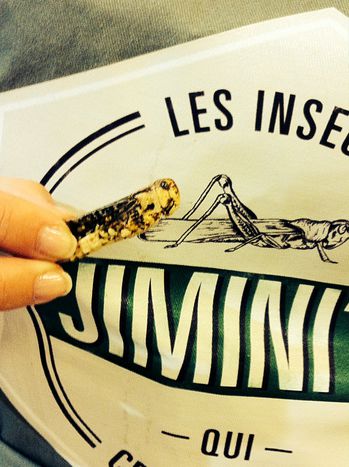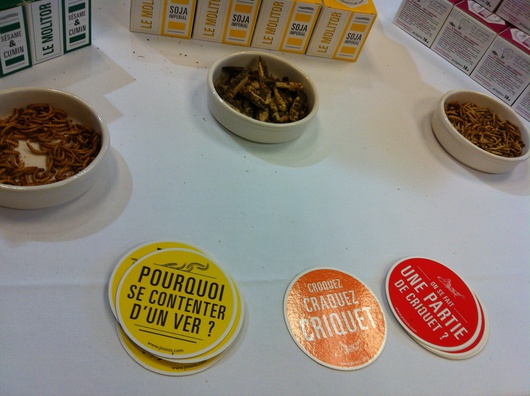
What's on the menu? Bugs!
Published on
They have been on the menu for more than 3.000 years, and yet they haven't succeeded to charm the taste of everyone.
Insect consumption has been recorded throughout human history. In Asia, the use of different species for everything from medicinal use to delicacy is widely known. In certain African countries, it is the main ingredient of traditional dishes. In Latin America, they have been used by the Aztecs as a colorant and protein source.
However, thanks to the "advanced marketing techniques" proven to change consumer attitudes and perceptions, it seems that the XXI century will be remembered. Insects are the new fashion trend for "delicatessen," and they are starting to fill our plates and delighting our palates with rich, crispy and crunchy sensations.
Last May, the Belgian AFSCA (Federal Agency for the Safety of the Food Chain) published a Circular concerning the authorisation for breeding and marketing 10 different insect species for food consumption.
Gourmet food?
Nowadays, there is a trend to have insects presented in very fancy way. Specialised Gourmet Markets offer a wide range of assortments, with prices between 6.90€ and 7.80€ for 10g...that makes 778€ per kilo! Large retailers offer less charm surrounding the insect products and the price for a small pot of tapenade (145g), which contains only 4% of insects is between 3-4€. Still pricey, isn't it?
To better understanding this food trend, we have interviewed a young French entrepreneur M. Clément Scellier, co-founder of Jiminis. A French company dedicated to produce/distribute our tiny friends.
Could you please explain to us what is Jiminis?
Clément: Jiminis is our brand, and we are producing eatable insects for the Apéro. They are dehydrated and garnished with different natural flavours. They are ready to eat, you can taste the flavour added, for instance we have crickets flavoured with paprika and sun dried tomatoes, or sweet curry. The flour worms are flavoured with garlic and herbs, sesame and cumin or sweet soya.
How many products do you have?
Clément: We have five different products; we are just starting to have a presence in a gourmet food store in Belgium, and with this taste event, we are aiming to show our products to consumers, as many Europeans have never eaten insects. Our goal is to teach consumers that insects taste good and can be fun to be tried and discovered with friends. They are also interesting from the nutritional point of view, so people should understand that eating insects can be good!
Where do Jiminis’ insects come from?
 Clément: Our insects are produced in Holland, then they are shipped to Normandy in France, where we transform them into the final product. We have decided to use only insects produced in Europe as this is a guarantee that sanitary regulations are respected. The European standards are higher than in other continents such as Africa or Asia. This is the main reason for us to use only European products to have the guarantee of quality and full respect of sanitary standards. We use only natural species, also produced in Europe. So we have strict quality control, including ingredients traceability. This is important to reassure the consumers as they might be concerned about the origin of the insects.
Clément: Our insects are produced in Holland, then they are shipped to Normandy in France, where we transform them into the final product. We have decided to use only insects produced in Europe as this is a guarantee that sanitary regulations are respected. The European standards are higher than in other continents such as Africa or Asia. This is the main reason for us to use only European products to have the guarantee of quality and full respect of sanitary standards. We use only natural species, also produced in Europe. So we have strict quality control, including ingredients traceability. This is important to reassure the consumers as they might be concerned about the origin of the insects.
We explain to clients that our insects come from a neighbouring country, and they are also transformed near you. This has helped consumers to feel confident in giving the products a try.
Which species are you using, and are they originally from Europe or abroad?
Clément: They are common European species. The cricket and the flour worm are from the list published as safe by the AFSCA. They don't look big or scary, as they are not exotic at all.
Can you explain to us further how insect production works?
Clément: There are specialised farms; they use 100% vegetable (GMO free) flours for feeding them. Then, a special cold dehydration process is used that allows them to keep all their nutritional properties intact. Later, they are "flavoured" in France, without using any heating procedure that might change the insects’ nutritional value or properties. Instead of frying them, we use "acacia gum" as a vehicle to add the different spices without using any oil.”
Can you tell us how you discovered your passion for insects?
 Clément: My associate Bastien Rabastens and I have tried some insects out of curiosity. There is a big difference from what is the reality in countries where there is a tradition to consume them, and the information available here in Europe through the media leading to some misconception. So, we tasted them and we realised that with a good seasoning they can become really nice with a great taste. So we decided to start this project in France as there was nothing available on the market when we started 2 years ago.
Clément: My associate Bastien Rabastens and I have tried some insects out of curiosity. There is a big difference from what is the reality in countries where there is a tradition to consume them, and the information available here in Europe through the media leading to some misconception. So, we tasted them and we realised that with a good seasoning they can become really nice with a great taste. So we decided to start this project in France as there was nothing available on the market when we started 2 years ago.
We started to learn the nutritional values and environmental facts about them. So we realised that there is a real potential for producing them, as they need less resources (energy, water, food, waste) than the traditional meat products. Also the FAO (Food and Agriculture Organisation) has released a report predicting a steady population growth that may reach up to 9 Billion people by 2050. So, a scarcity of resources is very likely; this is why we're aiming to educate people about the subject for changing feeding habits by 2050.
Food trend or new food alternative?
Clément: We believe there is a promising future for the insects, as there are plenty of opportunities for developing a new gastronomy based on insects as the main ingredient. We are working to enlarge our product range, with new recipes and homemade cakes. If we educate younger generations, there are real possibilities for insects to be adopted as an important source of proteins.
*Article proofreaded by Danica Jorden



